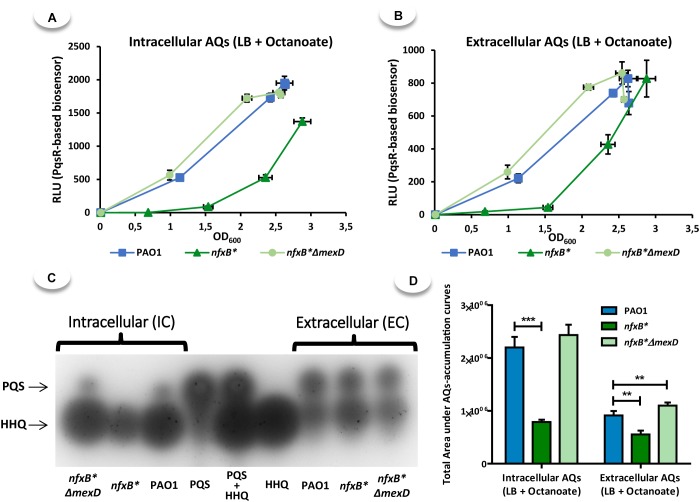FIGURE 6.
LB supplementation with octanoate increased the AQs production in PAO1, nfxB∗, and nfxB∗ΔmexD strains but, in the case of nfxB∗, but the accumulation levels remain being lower in nfxB∗ than observed in the other strains. To determine the time course production of AQs in PAO1, nfxB∗, and nfxB∗ΔmexD strains, we extracted these compounds from both the cells (A) and the cell-free supernatants (B) at different times along the cell cycle (4, 5, 6, and 7 h post-inoculation). Additionally, the last points of time course extractions were analyzed by TLC (C) in order to know the proportion of PQS and HHQ present on each AQs-extracts. The total area under each time course accumulation curve was quantified (D) and statistical significances were evaluated by using a Student’s two-tailed test and considered significant if P < 0.05, with a confidence interval of 95% (∗P < 0.05; ∗∗P < 0.01; ∗∗∗P < 0.001). The results show that supplementation of LB with 5 mM octanoate, even allowing nfxB∗ strain to accumulate levels of AQs out of the cells near to those in PAO1 and nfxB∗ΔmexD (B–D), was insufficient to restore the intracellular accumulation of PQS and HHQ (A,C,D). Furthermore, the fact that in TLC assay (C), the spot corresponding with HHQ present in nfxB∗ supernatant is slightly higher than that in PAO1 and nfxB∗ΔmexD, together with the evident low intracellular accumulation of HHQ in the nfxB∗ strain, confirm our hypothesis that MexCD-OprJ is able to extrude HHQ.

